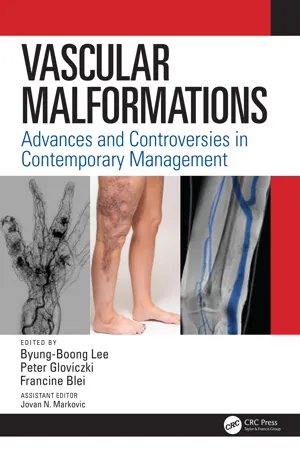
Vascular Malformations
Advances and Controversies in Contemporary Management
- 424 pages
- English
- ePUB (mobile friendly)
- Available on iOS & Android
Vascular Malformations
Advances and Controversies in Contemporary Management
About this book
This new book on vascular malformations brings together international experts to present advances and discuss controversies in the multidisciplinary management of patients with congenital vascular malformations.
Major advances in recent years in medical genetics, and tremendous progress in the fields of imaging and minimally invasive percutaneous interventions have revolutionized both evaluation and management of vascular malformations. The six major parts of this state of the art book ensure that the reader has the most up to date valuable clinical information to ensure the delivery of world class clinical practice. Beautifully illustrated with color line drawings, numerous photographs and informative tables, the advances and controversies of the full spectrum of vascular malformations are presented in 90 definitive chapters.
Vascular Malformations brings new information and unparalleled insights to vascular specialists and physicians, trainees and allied health professionals who participate in the care of patients with vascular malformations, either in a private practice setting or at a major institution in an interdisciplinary vascular center.
Frequently asked questions
- Essential is ideal for learners and professionals who enjoy exploring a wide range of subjects. Access the Essential Library with 800,000+ trusted titles and best-sellers across business, personal growth, and the humanities. Includes unlimited reading time and Standard Read Aloud voice.
- Complete: Perfect for advanced learners and researchers needing full, unrestricted access. Unlock 1.4M+ books across hundreds of subjects, including academic and specialized titles. The Complete Plan also includes advanced features like Premium Read Aloud and Research Assistant.
Please note we cannot support devices running on iOS 13 and Android 7 or earlier. Learn more about using the app.
Information

Table of contents
- Cover
- Half Title
- Title Page
- Copyright Page
- Contents
- Preface
- Foreword
- Contributors
- Part 1: Congenital Vascular Malformations (CVMs) in General
- Part 2: Arteriovenous Malformations (AVMs)
- Part 3: Venous Malformations
- Part 4: Lymphatic Malformations
- Part 5: Combined vascular malformations: Hemolymphatic malformations/Klippel–Trenaunay syndrome
- Part 6: Capillary Malformations (CMs)
- Epilogue
- Index